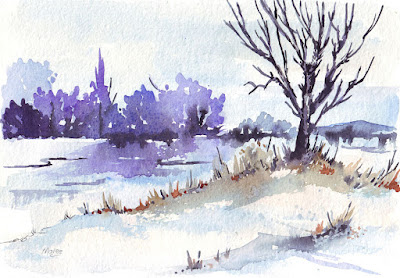Brew me a cup for a winter's night.For the wind howls loud and the furies fight;Spice it with love and stir it with care,And I'll toast our bright eyes,my sweetheart fair.~Minna Thomas Antrim Acrylics on canvas panel 12" x 9"
Acrylics on canvas panel 12" x 9"I've been experimenting a bit more with Acrylics these days, trying to break away from that "watercolour" look I'm still getting with my acrylics, and as the old adage goes, "A daily practice of sketching and painting gives you a chance to exercise the big three P's - practice, practice, practice!"
South Africa is famous for its sunshine. It's a relatively dry country, with an average annual rainfall of about 464mm (compared to a world average of about 860mm). While the Western Cape gets most of its rainfall in winter, the rest of the country is generally a summer-rainfall region.
The Western Cape gets most of its rain in winter, with quite a few days of cloudy, rainy weather. However, these are always interspersed with wonderful days to rival the best of a British summer. The high mountains of the Cape and the Drakensberg in KwaZulu-Natal usually get snow in winter.
Winter in South Africa (May to July) is characterised in the higher-lying areas of the interior plateau by dry, sunny, crisp days and cold nights. So it's a good idea to bring warm clothes.
The hot, humid KwaZulu-Natal coast, as well as the Lowveld (lower-lying areas) of Mpumalanga and Limpopo provinces, offer fantastic winter weather with sunny, warmish days and virtually no wind or rain.
A subtropical location, moderated by ocean on three sides of the country and the altitude of the interior plateau, account for the warm temperate conditions so typical of South Africa - and so popular with its foreign visitors.
At the same time, temperatures in South Africa tend to be lower than in other countries at similar latitudes - such as Australia - due mainly to greater elevation above sea level.
On the interior plateau the altitude - Johannesburg lies at 1 694 meters - keeps the average summer temperatures below 30 degrees Celsius. In winter, for the same reason, night-time temperatures can drop to freezing point, in some places lower.
South Africa's coastal regions are therefore warmest in winter. There is, however, a striking contrast between temperatures on the country's east and west coasts, due respectively to the warm Agulhas and cold Benguela Currents that sweep the coastlines.
Being in the southern hemisphere, our seasons stand in opposition to those of Europe and North America, so, yes - we spend Christmas on the beach!
From South Africa Travel InfoFrom my portfolios of
Landscapes with Water and
Acrylic Paintings on RedBubble




















